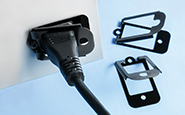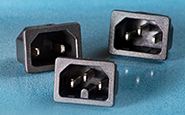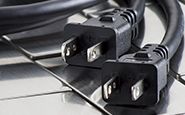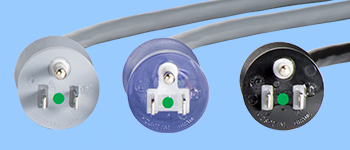More Information on Hospital-Grade Products
Introduction | Australia | Denmark | Japan | North America | International HG Equipment Standards | Hospital-Grade Power Entry Modules | Unique Device Identification (UDI)
For a full list of Hospital Grade Cords click here.
Hospital-Grade Power Cords, Cord Sets, Plugs, & Sockets
While some countries/regions have medical standards or recommendations, some hospitals may also have requirements that they choose to follow specific to their facility.
Australia
Medical equipment must meet AS/NZS 3200. All Australian plugs must be approved to AS/NZS 3112. In a medical application, according to AS/NZS 3200.1.0, a rewireable 3-pin plug has to be clear; it is optional for a molded plug to be clear. Some hospitals in Australia prefer to have a clear, transparent plug on orange, flexible cable.
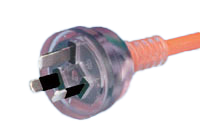 |
| 86210150 |
Standards:
AS/NZS 3200
“Medical Electrical Equipment”
AS/NZS 3112
“Approval and Test Specification—Plugs and Socket-Outlets”
Denmark
The Danish hospital-grade plus and socket are recommended for use in medical applications and specifications per Standard SB 107-2-D1. The socket is designed to prevent “normal equipment” from being connected and disrupting the main circuit in specific medical settings.
Red is the preferred color for select medical facilities in Denmark for hospital-grade cord sets, but it is not a requirement of the standard, per Danish authorities.
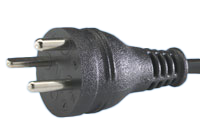 |
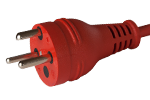 |
| 86280200 | 86281160 |
Standard:
Afsnit SB 107-2-D1
“Plugs and Socket-Outlets for Household and Similar Purposes”
Japan
DENAN is a mandatory national law administered by Japan’s Ministry of Economy, Trade and Industry. Cords, plugs, and sockets must carry the PSE approval mark.
Hospital-grade plugs and outlet-sockets need to be approved in accordance with JIS T 1021. Each shall be indelibly marked with an “H” and for plugs, a green dot is allowed. Hospitals have specific preferences when using hospital-grade plugs and sockets.
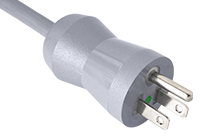 |
| 86277310 |
Standard:
JIS T 1021
“Hospital-Grade Outlet-Sockets and Plugs”
North America
Requirements according to the UL 817, CSA C22.2 no. 21, UL 498, and UL 60601-1 standards
The following briefly describes requirements found within these North American standards—UL 817, CSA C22.2 no. 21, UL 498, and UL 60601-1.
Molded-On Attachment Plugs and Connectors
For hospital-grade molded-on attachment plugs and connectors, the UL 817 and CSA C22.2 no. 21 requirements are applicable to the following configurations: 5-15, 5-20, 6-15, and 6-20. The blades on the plug shall be of solid brass material and the grounding pin cannot be easily bent or removed. (Note: CSA also allows a 1-15P which is an ungrounded plug with no ground pin.) Both the plug and connector need to be a straight or a right-angle type and molded onto flexible cord. Both need to be marked “Hospital Grade” with a green dot. Similar requirements are also found in UL 498.
Power Supply Cords
The type of flexible cord that is to be used on hospital-grade power supply cords is SJO, SJT, SJTO, SVO, SVT, SVTO, or other jacketed type cord of equal or harder usage, per UL 817. The conductor size is 18, 16, 14, and 12AWG.
Note about cord length: There is not a maximum length requirement for a cord set in the UL 817 and CSA C22.2 no. 21 standards. However, cord sets are derated when they become longer than 50 feet.
Hospital-Grade Extension Cords
The type of cord to be used for the hospital-grade extension cords includes SJO, SJT, SJTO or other jacketed type cord of equal or harder usage. The conductor size is 16, 14, and 12AWG. UL 817 states that, “A hospital-grade extension cord set shall have a maximum length of 15 feet.” (This cord uses a NEMA plug with a NEMA connector.)
Hospital-Grade Cord Sets
Hospital-grade cord sets need to have plugs that meet the above requirements and connectors that meet IEC 60320 requirements or another non-NEMA approved configuration. The conductor size is 18, 16, 14, 12, and 10 AWG.
Definitions
UL 60601-1 gives specific definitions of patient care equipment (intended for use in the patient vicinity) and patient vicinity (areas where patients are normally cared for). It also gives requirements for “hospital-grade” or “hospital only” plugs and cords.
Standards:
UL 817
“Cord Sets and Power-Supply Cords
CSA 22.2 no. 21-14
“Cord Sets and Power-Supply Cords”
UL 498
“Attachment Plugs and Receptacles”
UL 60601-1
“Medical Electrical Equipment, Part 1: General Requirements for Safety”
International Medical Equipment Standards
EN 60601
Medical equipment standard for European countries.
IEC 60601
Medical equipment standard for other countries, such as Australia, India, and non-European countries who follow the IEC standards (except for China, Korea, and Japan). Note: There are over 100 medical equipment standards in the IEC 60601. The general one is IEC 60601-1. Then starting with IEC 60601-2 through IEC 60601-118, each one focuses on a different piece of medical equipment.
Hospital-Grade Power Entry Modules
Hospital-grade equipment must meet special requirements. These requirements place special significance on fusing and filtering when selecting components used in medical equipment. Patient-connected medical equipment can be subjected to low-leakage current requirements. The use of a low-leakage filter in the 5μA range at 250VAC is desirable. In addition, fusing of both line and neutral connectors may be required (i.e. double fusing).
Medical Module Filter Information
Low leakage is achieved in modules with medical grade filters by removing the y-capacitors (Cy) from between the two signal paths (L and N) and ground, as well as resizing inductor values. Removal of these capacitors drastically reduces leakage current, however, it also has a negative impact on the overall filter performance (insertion loss). Filtering in medical grade modules will always be less effective than standard filters, but that is the trade-off for lower leakage currents.
Unique Device Identification (UDI)
Increasing concerns about product recalls, counterfeit devices, and patient safety has led the FDA (Food and Drug Administration) to start the process of developing a UDI (Unique Device Identification) System in regards to most medical devices. Currently identification methods are fragmented and it’s sometimes difficult to trace the original product back to the manufacturer.
The UDI is a unique numeric or alphanumeric code which includes a uniform list of product identifiers. As part of the UDI system, the FDA has created a GUDID (Global Unique Device Identification Database). This will have a standard set of basic identifying elements. According to the FDA website, “Most of this information will be made available to the public so that users of a medical device can easily look up information about the device. The UDI does not indicate, and the database will not contain, any information about who uses a device, including personal privacy information.”
The FDA’s Unique Device Identification System Final Rule was issued in September 2013. As with many new laws, there are several different compliance dates, depending on the type of medical device—whether it’s a Class III, II or I. For a complete list of compliance dates, check out the FDA website.
Basically, there are three steps to take to be in compliance:
- Create and assign the UDI.
- Choose the right labeling software to label the products with the UDI.
- Submit and store the UDI in the GUDID.
For a more detailed explanation, see the FDA and Medical Design Technology websites.
While medical cords are not classified as a medical device by the FDA, at Interpower serial numbers can be provided on medical cords per a company’s specific requirements.
Sources for UDI Information:
UDI Basics
www.fda.gov/MedicalDevices/DeviceRegulationandGuidance/UniqueDeviceIdentification/
UDIBasics/default.htm
Compliance Dates for UDI Requirements
https://www.fda.gov/MedicalDevices/DeviceRegulationandGuidance/UniqueDeviceIdentification/
CompliancedatesforUDIRequirements/default.htm


